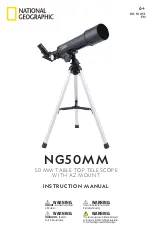
3
Operation
Step 1:
Set the scope and tripod outdoors and check the
alignment of the finderscope (if just assembled)
Step 2:
Adjust the tripod to a convenient height
Step 3:
Start with low power
Step 4:
Aim your GoScope (see below for target selections)
Loosen the tripod controls and look along the side of the tube
to point the objective lens toward the direction or objects you
want to view. Retighten to keep the target in the field of view.
Step 5:
Focus!
Step 6:
Change power if needed
The 25mm eyepiece is for wide angle/low power viewing. This
eyepiece will give you the brightest view. It delivers 20x power.
The 10mm eyepiece is for close-ups of Moon and planets,
after you find them with the wide angle eyepiece. The 10mm
eyepiece delivers a 40X power view… but things are four times
dimmer.
Observing tips
What Can You See?
The Orion GoScope II is equipped with the optics to give you a
“correct-image” view, similar to what you can see with binocu-
lars. Because of this, the GoScope II is an excellent terrestrial
telescope for looking at objects on the ground – so try it out
first during the daytime to acquaint yourself with its operation!
For astronomy you can see hundreds of craters on the Moon,
the four major moons of Jupiter, the major cloud bands on
Jupiter and the rings of Saturn. When Mars is in the sky, you’ll
be able to see its form, but surface details are likely too faint
and small to see in this telescope. If you take the GoScope
II to a location away from city lights (the darker, the better) a
telescope of this size can show you a lot! For example, most
of the “M-Objects” or Messier objects can be found with this
telescope – you’ll need a star map and patience, but this
scope can show you Open star clusters (Examples – M7, M6,
M11, M45); Globular star clusters (Examples – M13, M22, M5,
M3); Gaseous Nebulas (Examples – The Orion Nebula M42,
The Lagoon Nebula M8) and other galaxies outside our Milky
Way (Examples – The Andromeda Galaxy M31; The Sculptor
Galaxy NGC 253; M81 & M82).
Best targets
Best targets for city users:
• Daytime, terrestrial views
• The Moon
• Venus
• Jupiter
• Saturn
Best targets for rural users (everything above, plus):
• The Great Nebula in Orion – a spectacular glowing cloud
of gas in Orion’s sword; this is a “stellar maternity ward,” a
place where new stars are forming.
• The Summer Milky Way – the GoScope is well suited
to scanning the Milky Way to “discover” dozens of star
clusters.
• The Pleiades (M45) – a bright open star cluster
• The Andromeda Galaxy (M31) – the brightest external
galaxy
• The Double Cluster in Perseus
• M11, M6 & M7 – three bright, summer star clusters
• The Beehive Cluster – A big, open star cluster in the spring
sky
• The Great Cluster in Hercules M13 – a wonderful globular
star cluster, spring & summer
• M22 – another grand globular star cluster in Sagittarius, a
summer constellation
How Do I Change the Power?
The power of a telescope is calculated by dividing the focal
length of the telescope by the focal length of the eyepiece.
Example: For a GoScope II the focal length of the telescope is
400mm, so a 10mm eyepiece gives you 400/10 or 40 power.
Where Can I use My GoScope?
Terrestrial viewing: Anywhere you can take it! The 70mm
GoScope II is a powerful “spotting” scope or terrestrial tele-
scope that is more powerful than binoculars to give you real
close-ups.
For best results, DO NOT VIEW OUT WINDOWS. The glass
in a window is approximately 1000 times less accurate than
the optics of your GoScope – so it will soften your views, and
things will seem to be slightly out of focus. If you must view
through a window, use the lowest power available.
For nighttime, astronomical viewing: Again, use the GoScope
anywhere, but if you want to see objects outside our solar
system (“Deep Sky Objects”) you need to get away from city
lights. We know this isn’t practical for many people most of the
time, but that’s why the GoScope is made to be so portable –
take it with you on vacation or to a remote “star party.”
We cannot stress enough: you can see lots of deep sky
objects with a GoScope 70, but you need to use it away from
city lights. By away from city lights, we mean, if possible some-
place where the summer milky way is visible. At Orion’s head-
quarters in Watsonville, CA, that means an hour drive to a
remote location to fully test a telescope.
How Do I Find Objects In the Sky?
You wouldn’t be able to find a new city without a map, so how
do you find a new object in the sky? Use a star map, usu-
ally called by astronomers a “star chart.” The software included
with the GoScope has plenty of ways to generate maps of all
levels of details to find targets in the sky. To find an object,
first locate it on the map and note its position relative to sev-
















